Spello is a charming little village just 10 km southeast of Assisi. There is no hurry in this town, full of relaxed people that seem to be living La Dolce Vita. Spello certainly put a spell on me!
 |
| Roman Arch |
We are on the hunt for ancient towns along the Via Flaminia, a Roman road that starts in Rome and ends up in Rimini on the Adriatic Coast. The tiny township of Spello on the hillside of Mount Subasio, just 10 kilometres from the famous city of Assisi, has a laid-back vibe and an ancient history. This town of about 9,000 people was already inhabited by the Umbri tribes before the Romans arrived. It was called Ispellon or Eispellon, which has Greek origins. When the Romans came to settle in Spello in the first century B.C.E, they Latinized the name to Hispellum.
There are many Roman ruins left here in Spello. The ancient city walls, the aqueduct and the "porta" or gates still remain. The five main Roman gates are the Porta Urbica, Porta Consolare (with its statutes taken from a Roman temple), Porta di Venere or The Gates of Venus, Porta dell arche and Archo di Augusto. These Roman gates are also incorporated into the medieval city wall built in the 1300s. Unfortunately, the walls were knocked down in 1534 by Pope Paul III, and only the gates remain. The medieval gates are Portonaccio, Porta del Prato, Porta Montanara, Porta Fonteveccia and Porta Sant' Angelo. That is a heck of a lot of gates for a small town! In fact, you could spend the whole day looking for gates, arches, churches, and aqueducts.
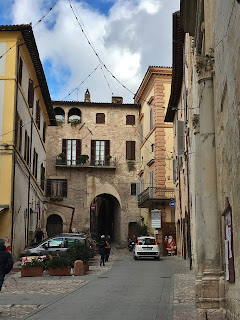
But we were looking for lunch! We found some free parking at the bottom of the hill leading up to Spello. TIP #1: FREE PARKING IS USUALLY LOCATED AT THE BOTTOM OF A HILLTOWN; PAY PARKING IS AT THE TOP. After climbing up what seemed like an endless staircase, we were at the main drag of Spello, Via Giuseppe Garibaldi, which leads to the Palazzo Comunale or Town Hall, on the main piazza in town. The flavour of this part of town is medieval, with the Town Hall building dating back to 1270! The neat little buildings are home to some great coffee bars, gift shops, enoteca and shops selling typical local Umbrian products like pasta, truffle paste, sausage and wine.
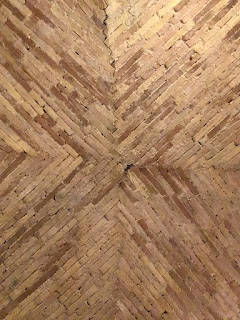 |
| Stone Ceiling |
We found a perfect restaurant called Il Pinturiccio in the main square across from San Lorenzo Church. Il Pinturiccio means "the little painter" and refers to the nickname of a famous Renaissance painter from Perugia, Umbria; Bernardino di Betto aka Il Pinturiccio. He was a tiny man (hence his nickname), but his brush packed a mighty punch. I have seen his paintings everywhere; Sistine Chapel, Vatican Library, Borghese Gallery, not to mention the Siena Duomo. In tiny Spello, Pinturiccio painted the Baglioni chapel of the Santa Maria Maggiore in 1500. I definitely recommend stopping in to see the glorious frescoes of this Renaissance painter. TIP #2: Bring some €2 coins to insert into the lightbox to illuminate the frescoes.
 |
| Pici With Grechetto di Todi Wine |
It was a busy lunchtime; the place looked small and PACKED with people. We thought there was no way to get a table for lunch, but our server took us through the back of the restaurant and into a large banquet room that looked like something out of the middle ages. Stone vaulted ceilings and wrought iron fixtures balanced by dainty chandeliers and arched french doors. We had this gorgeous room to ourselves! Everything on the menu was fresh seasonal, and homemade. I had the most fantastic pumpkin ravioli in handmade pasta, and my friend had pici with black truffle sauce. Pici are thick, hand-rolled pasta noodles like spaghetti, but the dough is only made with flour and water (sometimes with the egg white). Pici originates from the Sienna region of Tuscany, but it is prevalent in Umbrian cuisine as well.
 |
| Grechetto di Todi Grapes |
Then the wine! We tried to just get a half litre of white wine with our lunch, but this was a restaurant, not an osteria, so we had to buy a bottle. 😉 The famous white wine of Umbria is the Orvieto Classico. We are lucky enough to drink this at home in Ontario. It is that well known around the world. The white wine that we had was called Grechetto di Todi. Todi is a hill town near Orvieto that grows Grechetto grapes, and the Orvieto Classico white wine is a blend of Grechetto and Trebbiano grapes made in this corner of Italy since the Middle Ages. Grechetto vines come from Greece, and like the Sagrantino red grape, it is a late harvest grape. And like the Sagrantino grape, it is a low-yield variety with high sugar content and thick skins that resist the mildew in late-harvest grapes. For more on Sagrantino, see my blog. Grechetto is often used to make Vin Santo, a sweet dessert wine. This wine is also called Grecco in some places, but it has no relation to the Grecco Bianco wine of Calabria. I found Grechetto di Todi a beautiful light straw colour, and it tasted delicate, fruity and a bit floral, maybe. The perfect day drinking wine; so glad we got a bottle!
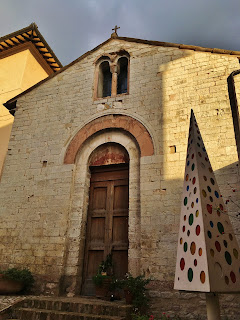 |
| San Martino Church |
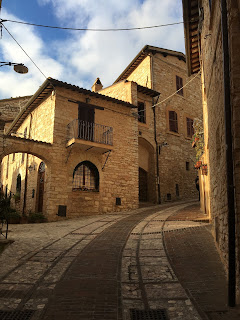 |
| Via Torre Belvedere |
 |
| Presepe At The Front Door |
 |
| Belvedere Of Spello |
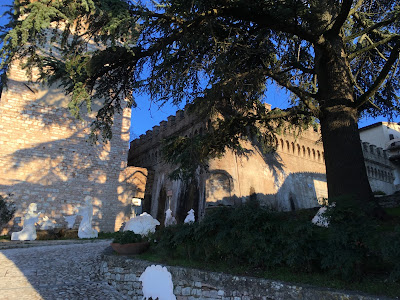
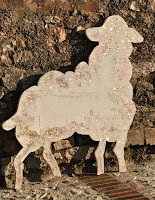
The Capuchins bought San Severino in the 1500s, and they built a convent up here. It looks like a fortress, but they had the cutest "glitter sheep" along the Belvedere leading up the terrace to their presepe at the entrance! Even nuns love glitter!
 |
| Infiorate Spello |
Each year in Spello, during the feast of Corpus Domini (The 9th Sunday after Easter), the Infiorata festival occurs. On the night of the Infiorata, hundreds of people working non-stop to create a mile-long carpet of flowers along the town streets and pictures and mandalas of flower petals in the piazzas! There is then a procession caring the Blessed Sacrament led by the Bishop of Spello over the carpets of flowers. The festival is trendy and is a great time to visit Spello when its gardens are all in full bloom. According to Easter, the festival moves around each year, but it is usually held in June.
With the winter sun warming the stone walls of the Belvedere, it was hard to leave our sunny perch. But the shadows were becoming long, so we decided it was best to make our way back home to Spoleto before dark. Passing by the old remains of a Roman Aqueduct on the way back to the car park, I am again astounded how ancient history is so entwined with day-to-day life here in Italy. When you SEE this continuum of time, you FEEL part of something bigger, part of something important. You can perceive that you ARE a piece of history. This is why travel is so important to me.




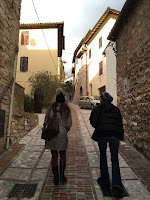
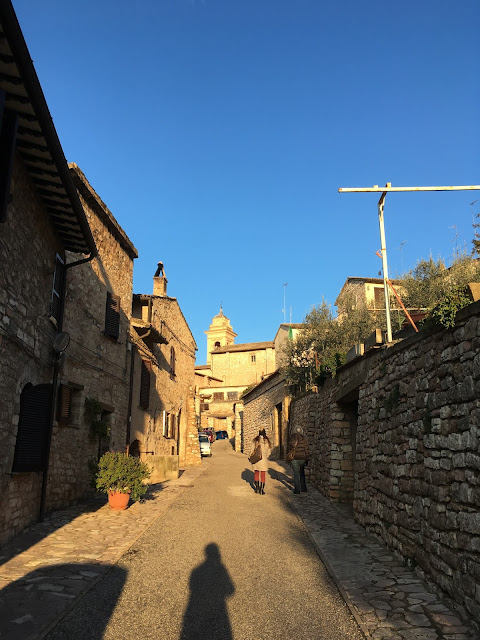

No comments:
Post a Comment